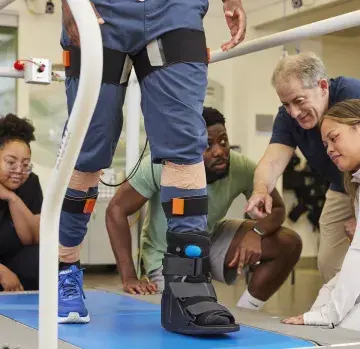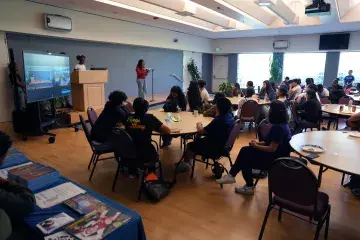World AIDS Day: SMU Alum Fighting AIDS 35 Years After Epidemic Began
AIDS began killing young gay men in San Francisco in the 1980s without warning and in the most brutal way. The suffering caused by the disease would set the course for Samuel Merritt University (SMU) alumna Emily Rymland’s life work.
“When the epidemic first started, I was working in the theater and watching my friends die,” she remembers.
First, she volunteered to answer phones at the San Francisco AIDS Foundation. Then, at the peak of the AIDS crisis in 1991, Rymland (pictured at right) decided to become a nurse and enrolled in SMU’s Bachelor of Science in Nursing program so she could work with people infected with HIV, the virus that causes AIDS.
Today, as we observe the 29th annual World AIDS Day, nearly 37 million people on the planet are living with HIV – most of them in sub-Saharan Africa – and an estimated 35 million people have died from AIDS-related illnesses since the start of the pandemic. While there are now effective drugs to manage the virus, most people around the world living with HIV or at risk for HIV do not have access to prevention, care, and treatment – and there is still no cure.
Rymland is now a nurse practitioner at the East Bay AIDS Center (EBAC) at Sutter Health’s Alta Bates Summit Medical Center in Oakland, where she works mostly with African American women.
“This is always the population I wanted to serve,” she says.
Twice a year Rymland travels to a remote region of Uganda, a country hard hit by AIDS, where she opened the area’s first health clinic in 2014 to provide HIV testing and other medical services. Called “Em’s Clinic,” it cares for some of the poorest people in the country – and the world -- and just recently gained permission to dispense antiretroviral drugs to treat those who test positive for HIV.
“I want to protect this community before HIV/AIDS takes it down,” says Rymland, who has raised $200,000 over the past two years to support the clinic in Buseesa in the Kibaale District.
Earlier this year, she met SMU student Paul Kiruuta at an HIV conference and the two discovered that they had a lot in common. Kiruuta, a native Ugandan, spent years as an agricultural student working with HIV-positive women farmers in rural Uganda who had lost their husbands to AIDS.
A few months later, Kiruuta became the first SMU family nurse practitioner student to do a clinical preceptorship at the East Bay AIDS Center, where he works under Rymland.
“He’s the most compassionate, loving, non-judgmental person ever,” she says of Kiruuta. “The patients love him.”
Kiruuta, who will soon graduate from SMU’s Entry-Level Master of Science in Nursing program, said that while he has worked with HIV-positive people as far back as the late ‘80s when HIV was “a death sentence,” working at EBAC is his first experience as a medical service provider.
“It’s very rewarding,” he said, noting that here he can individualize medication regimens for HIV/AIDS patients, whereas in Uganda healthcare workers are limited to prescribing whatever drugs are donated by the World Health Organization or the U.S. government.
Kiruuta (pictured at right) and Rymland say that treating HIV/AIDS in the U.S. is now easier than other chronic diseases like diabetes because the medication is so effective at controlling a patient’s viral load. But they both worry that young people, who didn’t witness the suffering of the early AIDS crisis, are becoming complacent.
Fighting AIDS in Uganda is difficult because of punitive laws against homosexuality and spreading HIV to sexual partners.
“The two main problems are stigma and criminalization,” says Rymland. “Because of fear of both, people are no longer seeking services. Also, many can’t afford to travel the long distances to seek testing or treatment even if the medications are free.”


